The Colomba is an Italian Easter dove cake that symbolises a peace dove. Today, it has become one of the traditional Easter Foods eaten in Italy. This is my plant based version of this traditional Italian dove bread for Easter called Colomba di Pasqua literally translates to “Easter Dove”.
Be warned, this recipe starts the night before you bake it and the following day will take several hours before you finally put it in the oven.
This recipe uses a ‘Biga’ which is a type of pre-fermentation used in Italian baking. Many popular Italian breads, including ciabatta, are made using a biga. Using a biga adds complexity to the bread’s flavour and is often used in breads that need a light, open texture with holes.
The Biga (dough starter) is made the night before. Make the starter, mix together 150g flour, 7 yeast, 100ml tepid water in a bowl, mix for several minutes into a dough, place in a lightly oiled bowl, cover and let it prove overnight.
The next day, mix the yeast with the tepid water and let sit for 5 mins until bubbles
Scrape the dough starter into a larger mixing bowl, add the rest of the flour, salt, yeast, sugar, plant butter, vanilla and orange extract.
Whisk the aqua faba until foamy, then pour into the bowl.
Pour in the yeasty water
Use a wooden spoon to mix into a loose dough, then add the candied orange and golden raisins and mix them in. When adding the candied orange peel, rub them with your fingers to separate them and scatter some of them around the dough fold in and scatter some more, otherwise they tend to clump together
Turn out the dough out onto a lightly floured work surface and knead by hand, stretching and folding until the dough is very smooth and elastic, at least 6 to 8 minutes
At the end of the kneading, turn the dough into a smooth ball and place it in a lightly oiled bowl, cover with clingfilm and place in a warm spot to rise for 2 to 3 hours or until it’s almost doubled in size.
Using the colomba cake case as a guide, shape the dough into a cross shape to fit the case and place it in the Colomba cake case.
Place the dough/case on a baking sheet, cover with greased plastic wrap and let rise again for another 90 minutes.

ingredients 
mix the biga with the flour, aqua faba, yeasty water sugar 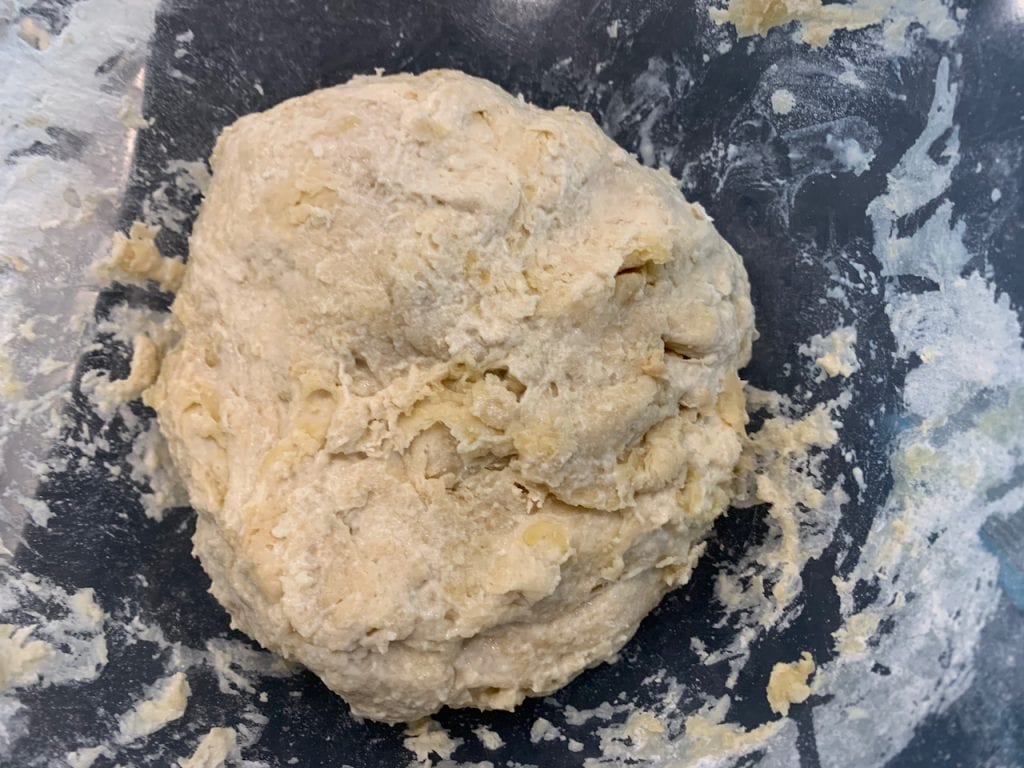
form into a rough dough 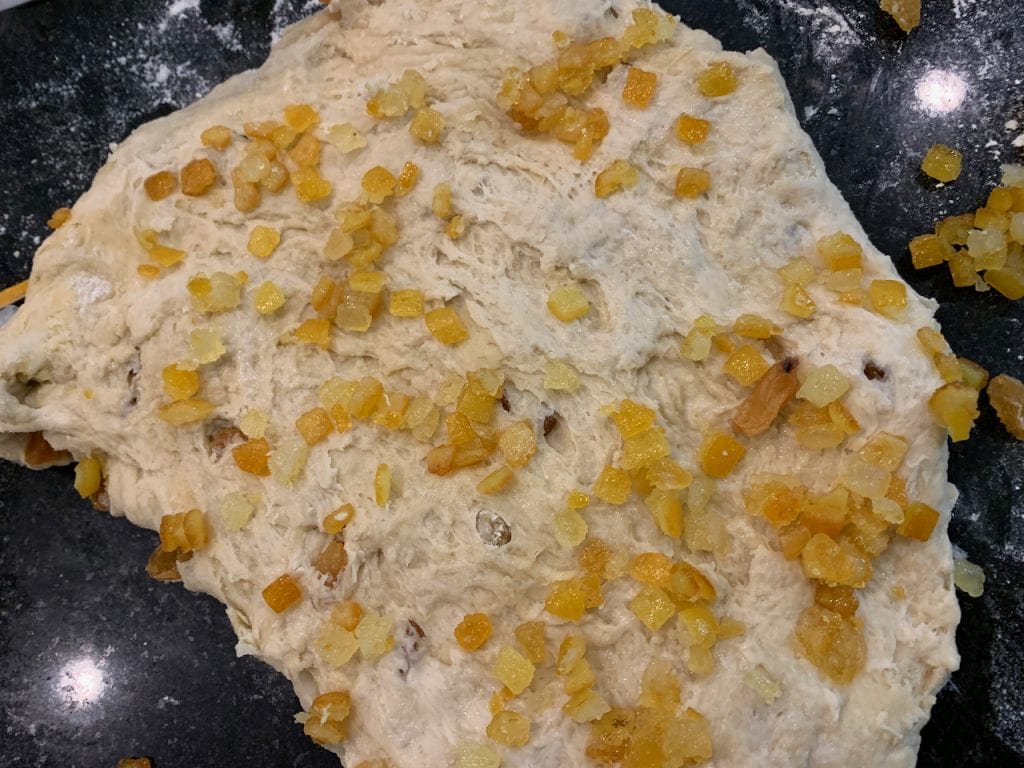
roll out and scatter the candied fruit and golden raisins 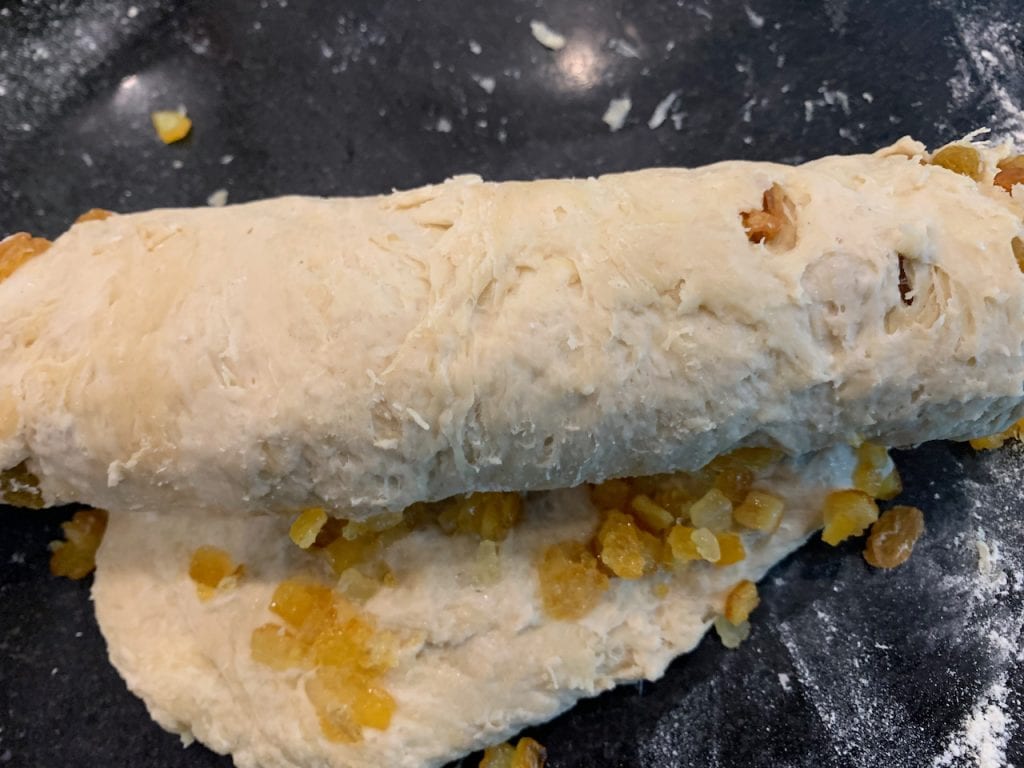
roll up and knead for several minutes 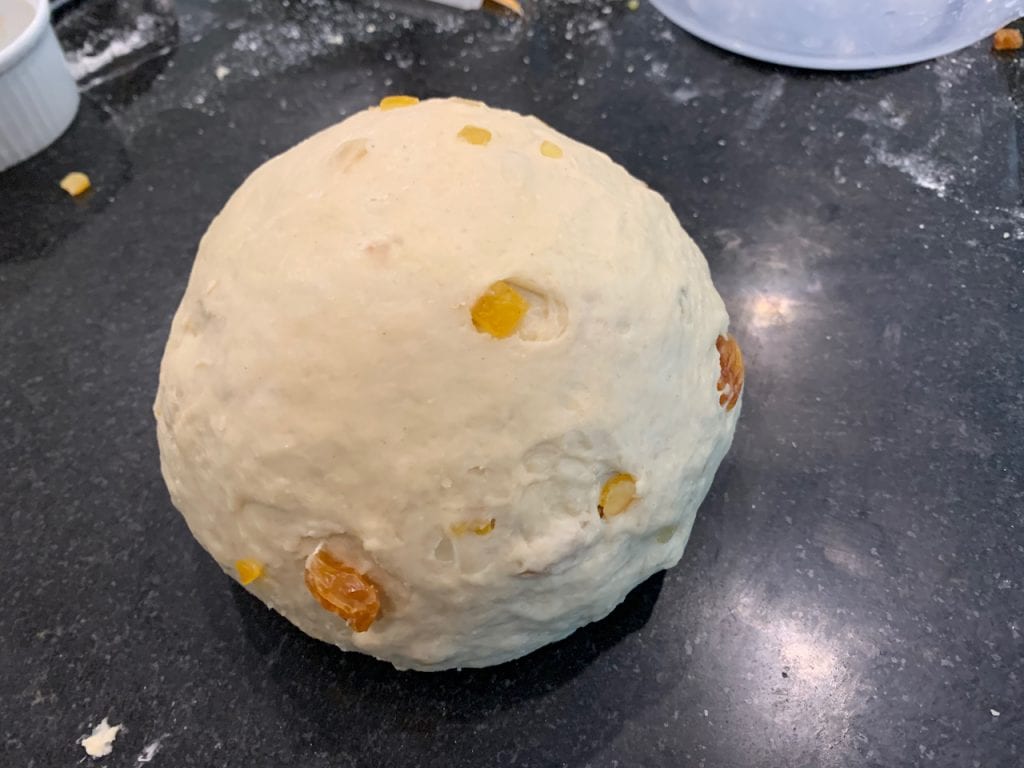
when the dough is smooth form into a ball 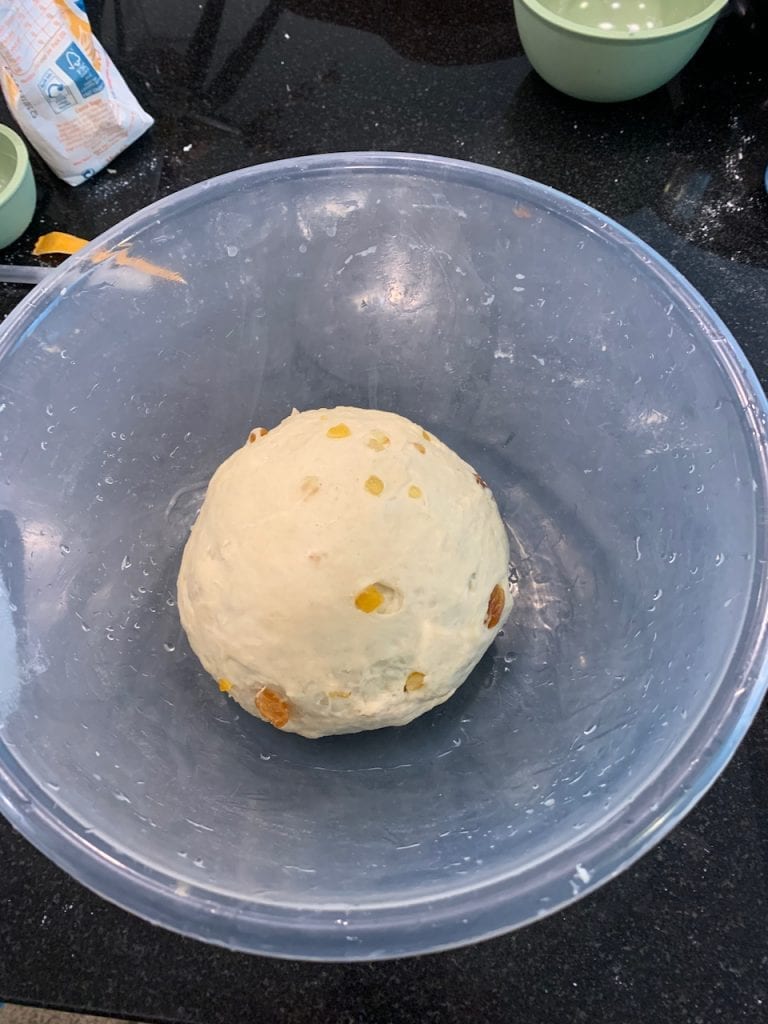
place in a bowl to prove for 2 hours 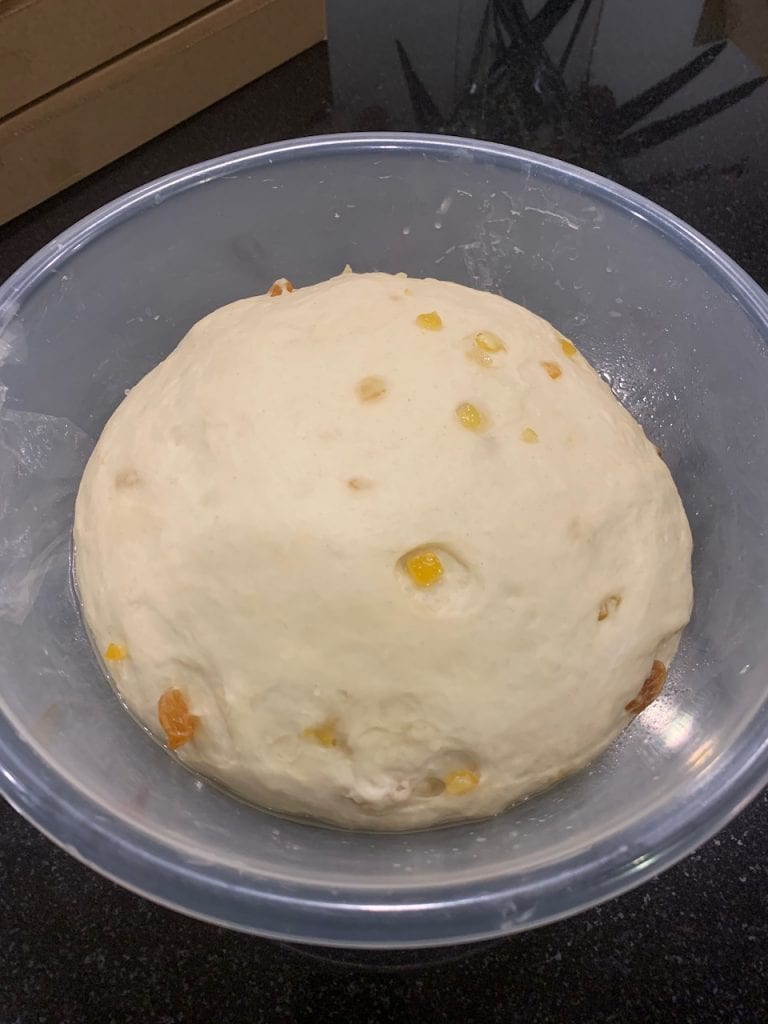
doubles in size after proofing 
cut in half slightly one bigger piece make into logs 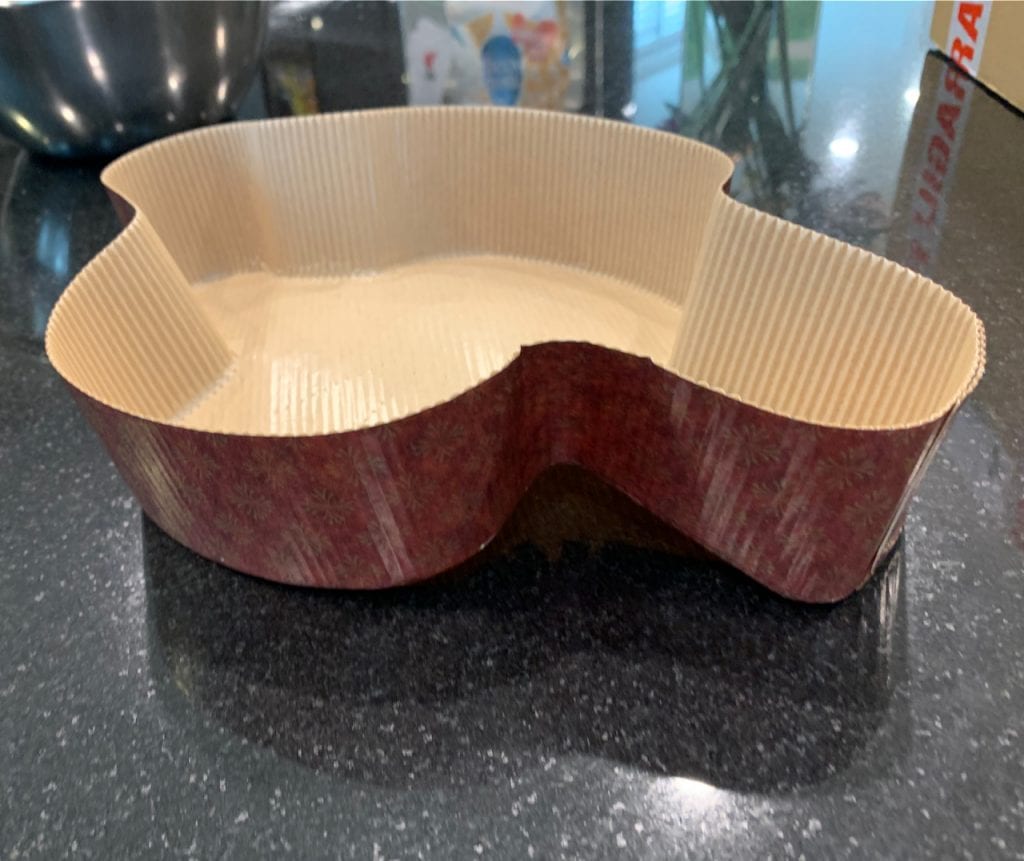
use fancy colomba cake case 
place dough in case 
allow to proof for 90 mins 
until risen ready to coat with topping
Towards, the end of the rising time, preheat oven to 170C.
While the bread is rising, make the topping. Mix the almond flour and sugar in a bowl.
Beat and whisk the aqua faba until foamy, then fold it into the almond sugar mix and keep folding until a paste is formed.
Liberally brush the top and any sides visible of the bread with the almond mixture and then scatter the pearl sugar and whole almonds on top.
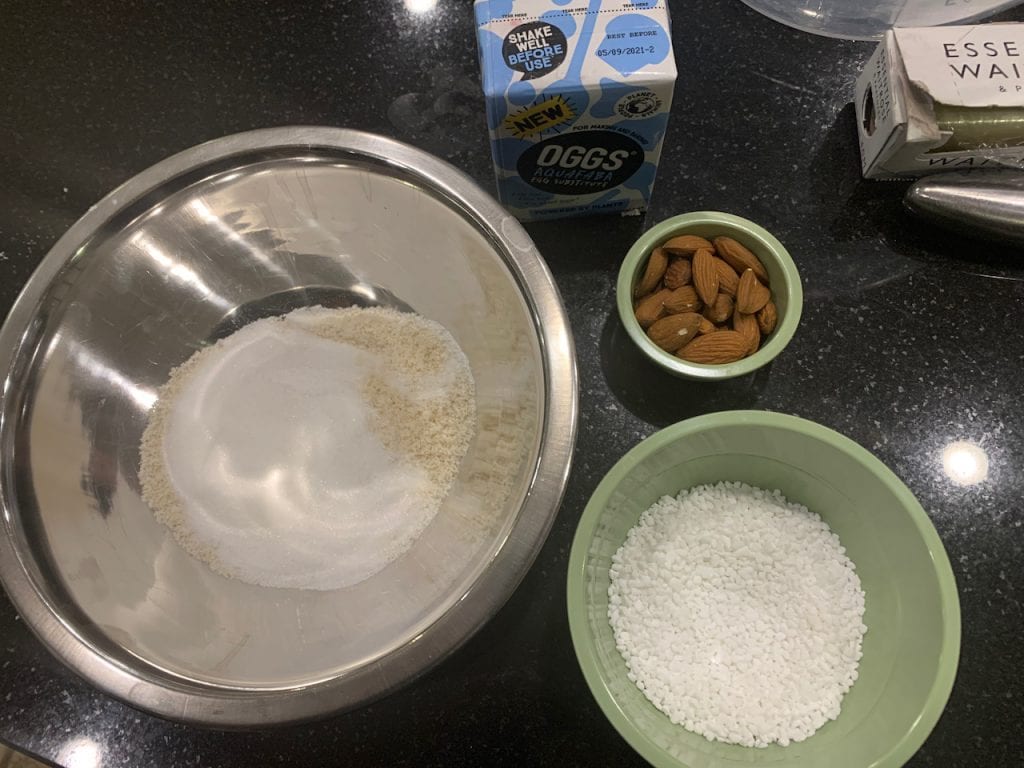
ingredients for topping 
whisk aqua faba into a form 
until its like a meringue 
fold in the almonds and sugar 
until completely mixed 
coat the top of the cake with the almond mixture 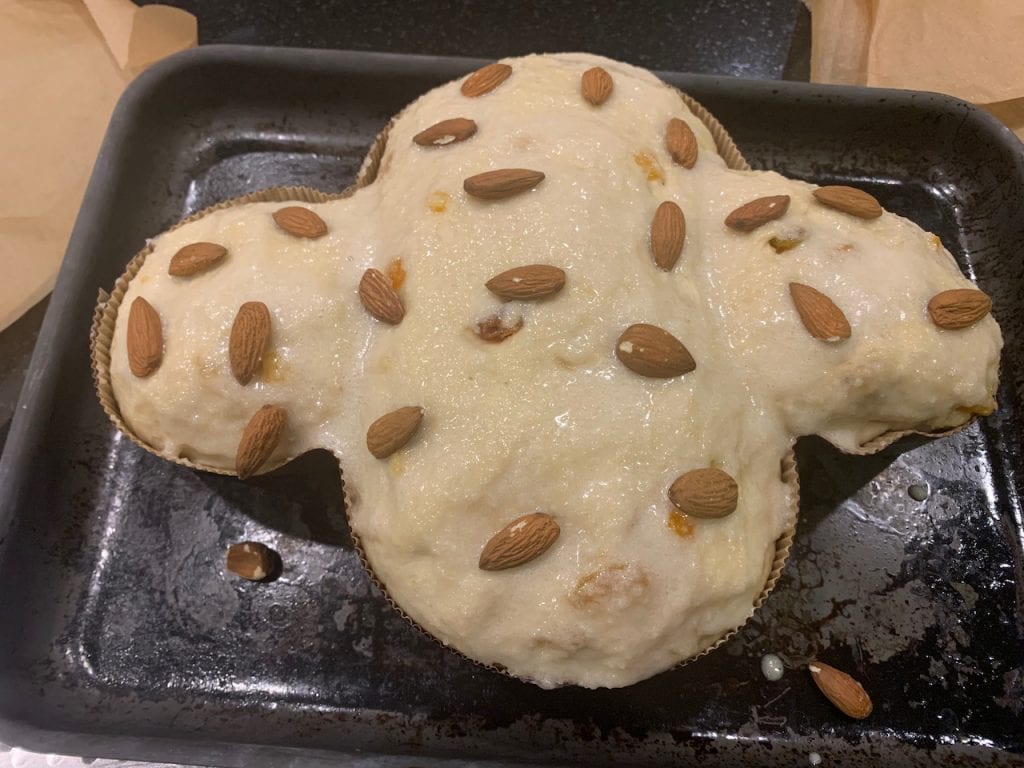
Place whole almonds over the top 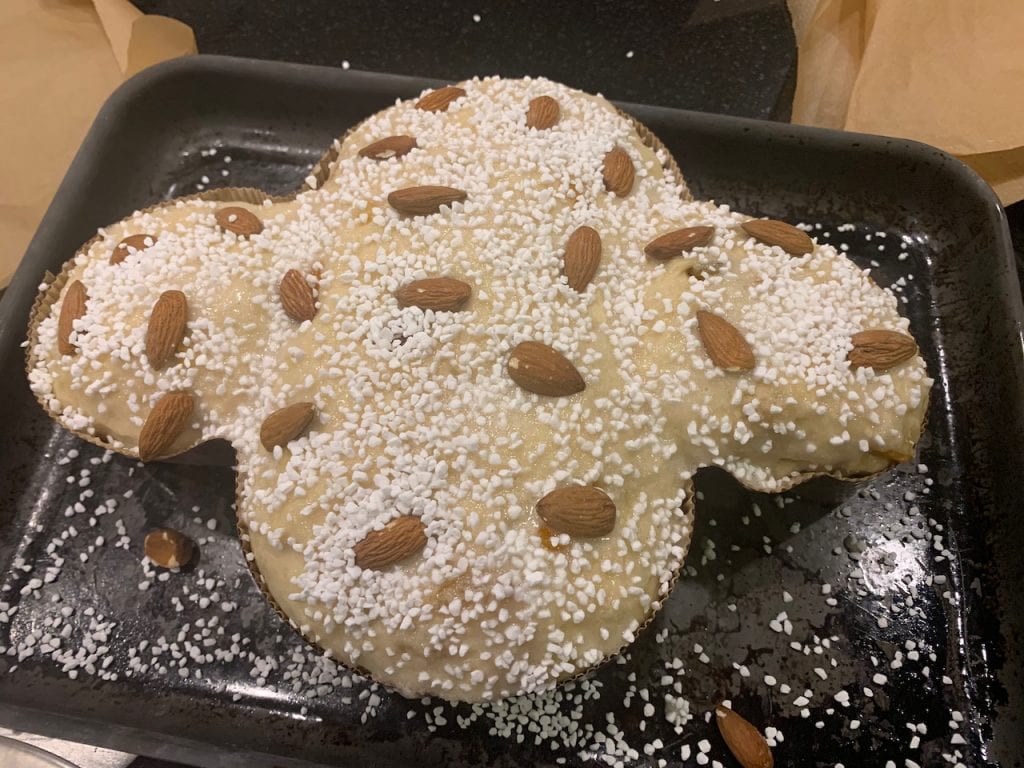
sprinkle nibbed sugar over the top
Bake for 25 to 30 minutes or until a cake tester comes out cleanly when inserted in the center.
If the bread darkens too much when baking, place loosely some aluminium foil on top.
Remove from oven, now at this point you have a choice to simply let it cool or to hang it upside down and let it cool. Many traditional Panettone and Columba recipes have an extra step of hanging the cake upside down during the cooling process to stop the cake from collapsing. They insert skewers into the bottom sides of the cake and use books to prop the skewers and let it hang upside down while it cools. I wasn’t convinced it is necessary as its mainly a bread, but given the amount of time it takes from start to finish, it would not be good to fall at the last hurdle, so I also added that extra step, just in case
However it did not go to plan, trying to hand the cake upside resulted in the cake falling apart, so I quickly up righted the cake and allowed it to cool and it did indeed sink
Once completely cool slice and serve.
Vegan Colomba di Pasqua
Ingredients
Dough starter
- 150 gm bread flour
- 100 ml tepid water
- 7 g dried yeast
Dough
- 450 g bread flour
- 7 gm dried yeast
- 150 ml tepid oat milk
- 1 tsp sea salt
- 75 g caster sugar
- 4 tbsp aqua faba
- 50 g plant butter
- 1 tsp vanilla essense
- 2 tsp orange exract
- 60 g candied orange peel
- 60 g golden raisins
Topping
- 3 tbsp aqua faba
- 30 g ground almonds
- 40 g caster sugar
- 30 g whole almonds
- 2 tbsp pearl sugar
Method
Dough starter
- The night before, make the starter, mix together 150g flour, 7 yeast, 100ml tepid water in a bowl, mix into a dough, cover and let it prove overnight.
Main dough
- mix the yeast with the tepid oat milk and let sit for 5 mins until bubbles
- The next day, in a large bowl, scrape in the dough starter, add the rest of the flour, salt, yeast, sugar, melted plant butter and vanilla and orange extract.
- Whisk the aqua faba until foamy, then pour into the bowl
- Pour in the yeasty milk
- Use a wooden spoon to mix into a loose dough, add the candied orange and golden raisins into the dough and mix them in.
- Turn out the dough out onto a lightly floured work surface and knead by hand , stretching and folding until the dough is very smooth and elastic, at least 8 to 10 minutes
- Finally turn the dough into a smooth ball and place the dough in a lightly oiled bowl, cover with clingfilm and place in a warm spot to rise for 2 to 3 hours or until it's almost doubled in size.
- Turn the dough out onto a floured surface and using the cake case as a guide mould the dough into a cross shape to fit into the case. Place the dough into the case
- Place the dough/case on a baking sheet, cover with greased plastic wrap and let rise again for another 2 hours.
- towards the the end of the rising time, preheat oven to 170C.
Topping
- While the bread is rising, make the topping. Mix the almond flour and sugar in a bowl
- Beat and whisk the aqua faba until foamy, then fold it into the almond and caster sugar mix and keep folding until a paste is formed.
- Liberally brush the top and and sides of the bread with the almond mixture and then place the almonds around the top and then scatter the pearl sugar over the top.
- Bake for 35 to 50 minutes or until a cake tester comes out cleanly when inserted in the center.
- If the bread darkens too much when baking, put some aluminium foil as a loose top.
- Check with a cake tester that it is cooked through and remove from oven, insert 4 long skewers into the bread on all sides and hang the bread upside down. I used a pile of books on all sides.
- Let it cool completely, remove the skewers, slice, and enjoy!
Notes
They insert skewers into the sides of the cake and use books to prop the skewers and let it hang upside down while it cools. Wasn’t convinced it is necessary as its mainly a bread, but given the amount of time it takes from start to finish, it would not be good to fall at the last hurdle, so I also added that extra step, just in case 🙂
Nutrition
(All nutritional information is based on third-party calculations and should be considered estimates. Actual nutritional content will vary with brands used, measuring methods, portion sizes and more).


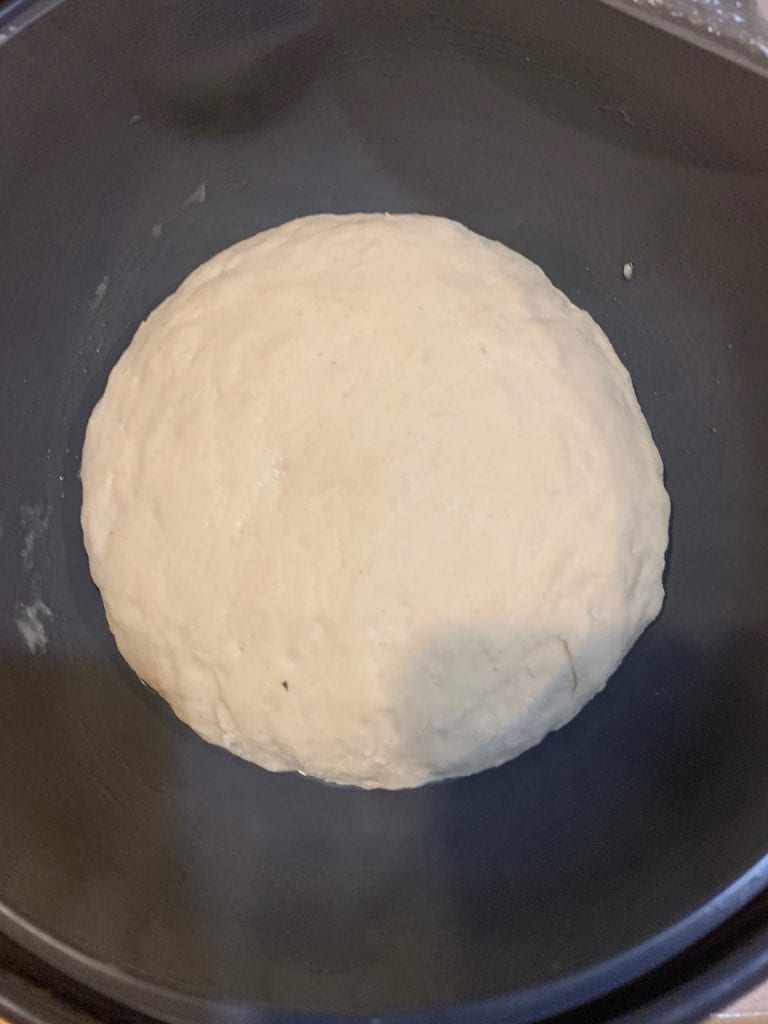
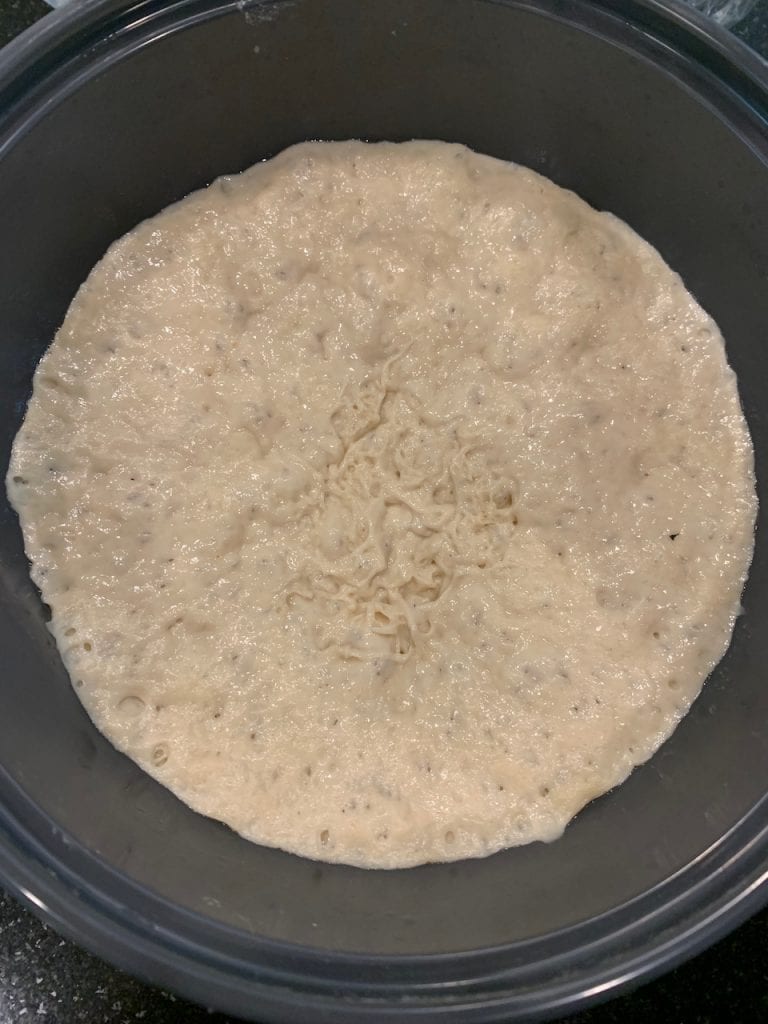
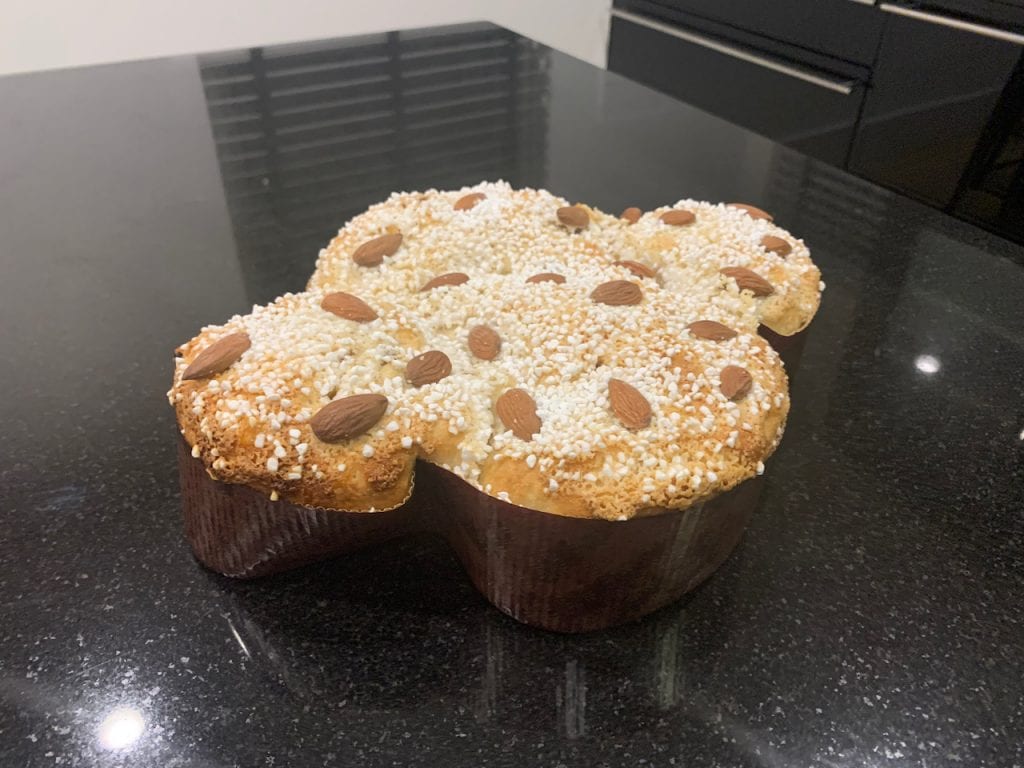

1 thought on “Vegan Colomba di Pasqua (Italian Easter Dove bread)”
Your recipe is very good by the way but I tweaked it a little bit. I have made colomba di pasqua many years before I became vegan. I tried other vegan recipes but found yours to be closest to the original. I recommend adding a pinch of cream of tartar when beating aquafaba as it stiffens a little and not be as runny for the topping. Cornstarch works for egg replacement in baked breads too and offers a lighter texture. I normally add turmeric to give it that yellowish tint as there are a lot of egg yolks in the original recipe. I also added orange zest to the dough to give it a boost in flavour and a couple of drops of pure almond extract for the topping. Traditionally orange peel is only used. Orange peel and raisins are characteristics of a traditional panettone. But now Italy has many variations (some with only raisins and others with chocolate). Sorry for the long winded comments. My mother was Italian and made this every single Easter as well as panettone.